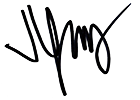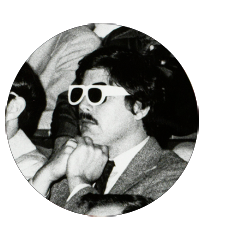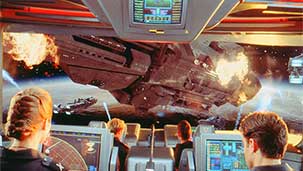Dear Cinema Lovers,
I’ve been thinking a lot about going to the movies. For obvious reasons. Of the countless activities I’ve missed in the last 10+ months – travel to foreign places, time spent with friends and family – the one the invokes the most melancholic longing is leaving my house to sit in the dark with a bunch of strangers.
A movie theatre is a strange public place. You go there to share an experience with others, but it happens, for the most part, in isolation, in silence. At any given moment you might send signals about how you’re feeling – you laugh, or gasp, or cheer – but it’s ultimately a very internal experience. For introverts, there’s no better leisure activity—to be among others, to be a member of a short-lived community, and to confer indirectly with them (no eye contact required). It’s not that different than going to church, where you sing hymns to hear your voice lost in a chorus of others, and the point is to remind yourself that you’re not alone in the world.
It’s difficult to separate the quality of the moviegoing experience from the quality of the movie itself: I have, on many occasions, walked out of a theatre stunned or moved or thrilled simply because I’ve seen a stunning, moving, or thrilling film. But I want to focus, here, on movies that I enjoyed because I saw them in theatres—movies that I might have otherwise felt agnostic about, but that instead I adore, all because I watched them with others, in the dark, alone but together.
Twister
Date: May 1996
Theatre: Capital Theatre, Yellowknife, NT
The dawn of the CGI-era may have occurred in earnest three years earlier, when Jurassic Park hit theatres, but the first time I felt the true power of computer special effects on the big screen wasn’t watching Laura Dern and Sam Neill run away from a T-Rex—it was watching Helen Hunt and Bill Paxton run away from the weather.
That Twister was also written by Michael Crichton (along with his wife, Anne-Marie) is no accident; he was a master of marrying real science – real physics, real structures – with the most fantastical adventure stories. To this day, that remains the secret to creating something awe-inspiring onscreen: all those manipulated pixels must carry a weight, and must move with a familiar logic. Twister, despite being a movie about wind, had a substance to it. The experience was visceral. The roar of the storm in the speakers, the towering Texan skies on the towering screen—it transported me.
At its heart, Twister is a chase film—people are chasing tornados, tornados are chasing people, people are chasing people inside of tornados. It’s all shot in Jan de Bont’s handheld style, but it never feels as messy and muddled; in fact, that documentary vibe make the effects feel more authentic, more frightening. The theatre was full that night, and the audience seemed as thrilled as I was. There are some great crowd-pleasing moments in that flick: the first tornado tearing through a barn and absorbing the debris, the drive-in movie screen torn apart in the middle of The Shining—even the flying cow got a big laugh.
The following week, I convinced my mom to take me to see it a second time; it seemed to me, then, that this film was a watershed moment, and would be remembered in the decades to come as a great leap forward in cinematic immersion. I wanted her to be able to say that she had seen it in theatres, too—that she had been there to witness history.
Starship Troopers
Date: November 1997
Theatre: Southland Mall, Regina, Saskatchewan
It’s one of the strangest, most subversive wide-release blockbusters of the last three decades: a satire of fascism wrapped inside a Beverly Hills 90210 parody disguised as a sci-fi action flick. And while much has been written in the last two decades about the real intentions and real legacy of Paul Verhoeven’s _Starship Troopers, it was, at the time, just another movie about spaceships and lasers and aliens.
So imagine this: a Friday night in south-central Saskatchewan, in a theatre packed full of rowdy dudes and their reluctant girlfriends. No one in attendance is interested in the film’s politics. No one is prepared to contemplate the ideological failings of radical socialism. They are there to see shit get blown up—and Starship Troopers obliged. What resulted was the loudest, most raucous time I’ve ever had at the movies. The room buzzed with energy. The bloodlust was palpable. As the troopers brutally mowed down the spiderlike bad-guys, the audience roared. When Rico growls that famous line: “I’m from Buenos Aires, and I say kill ‘em all!” people stood and clapped as if they, too, were from Buenos Aires, and had just lost their friends and family to a deadly bug asteroid. The screening itself became the exact sort of jingoistic celebration of violence that the film was supposedly criticizing. Today, as I watch footage of nativists and white supremacists marching through the streets, I think back to my experience that night: how easy it is, in the heat of the moment, in the din of screaming voices, to be drawn along with the crowd—and before you know it find yourself in an unfamiliar and disturbing place: cheering for death, and a little bit in love with Denise Richards.
In America
Date: March 2002
Theatre: World Exchange Theatre, Ottawa, ON
There’s nothing more ironically dystopian about the streaming era than the gift/curse of infinite choice. No matter how many films you watch, how many TV series you binge, you’re always behind, you’re always failing. To watch one movie is to not watch ten thousand others.
Entertaining (or edifying) yourself shouldn’t feel like homework, but as we’re assigned more and more tasks – you have to see this award-winning film, everyone is talking about that TV show – the pressure to check the box and move on quickly to the next thing has become untenable. For me, at least. I watched The Trial of the Chicago 7 on Netflix in mid-December, and thought it was pretty good. A few weeks later someone asked if I’d seen it, and I honestly couldn’t remember. Nothing sticks. You’d think these infinite options would help us find more things, new things, different things, but instead it denies us the magic of having limitations; specifically, the chance to accidentally discover something we weren’t looking for.
In the spring of 2002 I had a day off work, and all I wanted to do was see a movie. My options were limited—there were only one or two theatres I could get to by bus, and only one or two flicks at each of them that I hadn’t yet seen. By this process of elimination, I ended up buying a ticket to see Jim Sheridan’s In America, which I’d heard was getting decent reviews, but otherwise knew nothing about. All I wanted was a dark theatre, some popcorn, and a few hours of solitude.
There’s a certain magic to going in cold to a movie—the magic of travelling somewhere without baggage, unburdened, light on your feet. And watching In America in that empty theatre on a weekday afternoon was exactly the sort of transportive experience you hope for when you engage with good art: to believe, briefly, that you’re someone else, and for that belief to be sustained from start to finish (and, if you’re lucky, beyond). When this happens in a movie theatre – when you’re outside the confines of your home and your head – this belief becomes physical. You are immersed. This is where the size of a screen matters. A movie needs to be bigger than your body so it can swallow you up. Even a movie as small and intimate as In America.
Two decades later, I couldn’t tell you much about the plot of In America (thought I do recall it has, itself, a great movie theatre moment: the struggling Irish family scrapes together some money to escape the summer heat by going to see E.T. at an air-conditioned cinema). What I remember most is the feeling I carried with me when I left the theatre: a vertiginous sense of having travelled forward in time, the world around me slightly unrecognizable—briefly an alien in my familiar world.
21 Jump Street
Date: March 2012
Theatre: Paramount Theatre, Austin, Texas
Casey Tourangeau and I ended up at the world premiere by accident—21 Jump Street was simply one of the movies we were able to get tickets for when we reached the front of the line earlier that morning. Not typically the kind of film you’d choose to see at a festival like SXSW; better seen, one might think, at a suburban multiplex on a Saturday night (with those rowdy boys in south-central Saskatchewan, maybe).
That night we joined the line several blocks away, and, an hour later, when we’d reached the theatre doors, we saw the red carpet, the throng of photographers, the screeching fangirls craning for a glimpse of Channing Tatum, and it was clear that maybe this was something more than a moneygrubbing remake of a flash-in-the-pan 80s cop show destined to air incessantly on TBS.
It was, as they say, a friendly crowd (the fact that they serve beer at the Paramount certainly amplified the mood). The cast and crew were right there in the audience with us, middle row, middle seats, at the eye of the storm. Everyone around them was primed to show their gratitude for simply being there; they would have laughed at anything.
21 Jump Street, it turned out, didn’t need that head start. It was genuinely funny. Maybe one of the great (and unexpected) comedies of the decade. It was such a surprise to everyone there that the laughter filling the theatre in the first twenty minutes was hesitant, almost disbelieving. But with every successive gag, the momentum grew. Soon, the noise was deafening. Every joke hit hard. Every beat worked perfectly. When Tatum and Jonah Hill are tripping major balls in front of their oblivious gym teacher, I had to hide behind the seat in front of me. It was a matter of life and death; I couldn’t breathe, I needed to look away. At points, the laughter was so loud, and lasted so long, that we missed entire scenes of the film. The Johnny Depp cameo partway through the third act caused an ovation that lasted almost to the end credits.
When the Q&A wrapped up the audience began shuffling reluctantly towards the exits. No one wanted to leave. We didn’t, either. There was a sense that we had witnessed something exceptional, and we were, I think, a little disappointed that it had to end. The only thing that awaited us on the outside, after all, was the real world, and how could it compare to the ecstatic place we’d just come from.
Skyfall
Date: November 2012
Theatre: Silver City IMAX, Ottawa, ON
It’s virtually impossible, today, to avoid seeing images and clips from a major studio release: the advertising for these films is so ubiquitous, so intrusive, that one walks into these movies having seen glimpses of all of the major set-pieces, all the iconic moments, all the plot-twist teases. It was Christopher Redmond who got me into the habit of avoiding trailers (I’ve even adopted his technique for when they play in the theatre: cover your ears, tuck your head into the collar of your shirt). I realized, talking to him, that I perhaps had never gone into a film I was excited to see without having watched the trailer a thousand times, without having pieced together, in my head, the beats of the story, how all the explosions and snippets of dialogue fit together. I aways know what to expect, and therefore expect it.
As much as I love the art of the trailer, I have come to love the experience of going into a movie ice-cold, knowing nothing, possessing no preconceived idea of what is about to unfold in front of me. And with Skyfall, I managed to do this with one of the most familiar, self-cannibalizing film franchises of all time.
The theatre was packed, that night. The crowd was eager, and so was I. In the preceding months I’d managed to avoid all the trailers, clips, and banner ads. I made it all the way to the advance screening without having seen a single frame, and, from the very first moment, my expectations were defied—there’s wasn’t even the traditional 007 gun-barrel sequence to start things off. By the end of the opening sequence, when Bond is shot and falls off a train into the ravine below, I found myself genuinely surprised. And what a strange experience, to be surprised by a film whose master blueprint has been followed faithfully for half a century. I had no idea where the film was going. I was hurtling into darkness. Every image – from the neon Jellyfish in downtown Shanghai to Javier Bardem’s bleached blond hair – was brand new to me, and, in its newness, thrilling.
And why did it matter that this happened in a theatre? Because it pulled me outside of my own head. It externalized the watching experience, turned it from an intellectual exercise into a visceral one, and I found myself feeling more keenly than ever the tidal shifts of the audience’s mood; with no points of reference point, no way to get my bearings, I was drawn along with them, this way and that, strangers in a life raft riding the swells and hoping we ended up somewhere safe.
And we did. That night, at least. I’ve seen Skyfall a few times since, and, though I still think it’s pretty good, it hasn’t lived up to that first viewing. It couldn’t. Because the best and worst thing about seeing a movie in the theatre is that it’s a temporary experience; you can’t take the feeling with you, only the memory. And right now, all we have are these memories.
I like getting to the movies early. I like sitting in the dim light while others shuffle in. And then that lovely moment when the lights dim and the speakers crackle. It incites a physical reaction in me—every single time: a chill, a clench, a throb, a shiver. I live for it. I hope to feel it again soon.
Sincerely,

Jared





